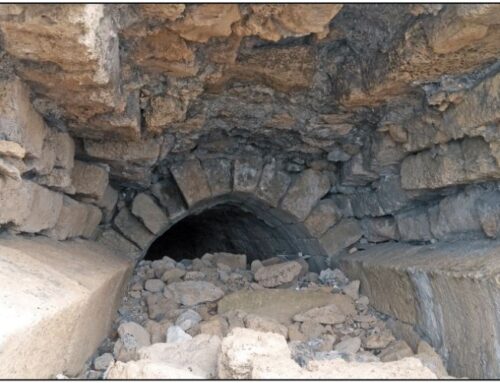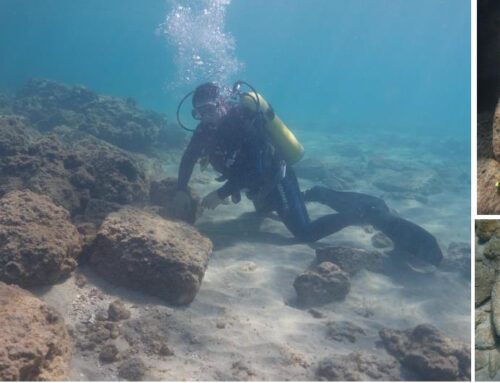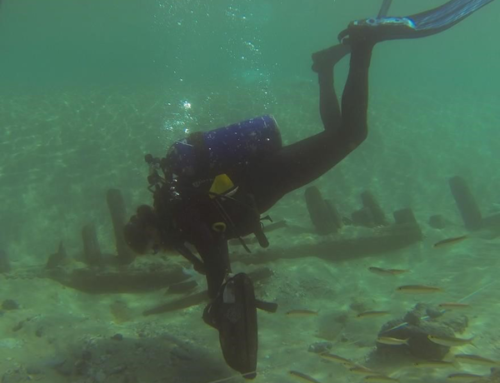Sailing Ma’agan Mikhael II – 2019
Dr Deborah Cvikel
Leon Recanati Institute for Maritime Studies and Department of Maritime Civilizations, University
of Haifa, Haifa 3498838, Israel
Introduction
The wreck of the Ma‘agan Mikhael ship was discovered off the Mediterranean coast of Israel in 1985, and excavated in 1988 and 1989 by the Leon Recanati Institute for Maritime Studies at the University of Haifa. A significant portion of the wooden hull, 11.15 m long, 3.11 m wide, and 1.5 m deep, survived. All the timbers were excavated, retrieved from the seabed, conserved and reassembled. The ship was dated to 400 BC. The reassembled archaeological find is exhibited in the Hecht Museum at the University of Haifa.
The hull was made of Pinus brutia, with some elements of Quercus spp, and was built ‘shell- first’ – the strakes were edge-jointed by pegged mortise-and-tenon joints. This 30-year-long research project was completed by building a full-scale sailing replica of the Ma‘agan Mikhael ship, based on the archaeological find. Iconography was used to supplement missing information, and comparisons were made with reconstructions of nearly contemporary shipwrecks. A complete set of hull lines was generated by computer-aided design and model building.

Fig 1. The Ma‘agan Mikhael II leaving Herzliya Marina on her way to Cyprus (Photo: A. Yurman)
After construction lasting about two and a half years, the replica was formally launched on 17th March 2017, and named Ma‘agan Mikhael II. She is 16.6 m in overall length and 4.3 m in beam, with a displacement of 22.9 tons, and rigged with a mast carrying a single square sail, based on iconography of vessels of the period. The hydrostatic characteristics of the ship were tested, and found to comply with present-day requirements for stability and seaworthiness. After the ship received its seaworthiness certificate from the Israeli Ministry of Transport, the replica team carried out a series of trial sailings in Haifa Bay. The goal of these sailings was to acquaint the crew with the ship, handling the square sail and steering oars, manoeuvring and anchoring.
Participating in the sailings were the replica team and visitors who had supported the project and came to see the ship in action. In addition, there were also sailings with students from the Department of Maritime Civilizations at the University of Haifa, and cadets from the Israel Nautical College at Akko. One goal of these sailings was to formulate a teaching plan for schoolchildren in various grades to learn in practice about an ancient square-rigged ship.
Sailings along the coast of Israel
The major challenge in sailing with a square sail is in making way to windward. Experimental sailings were conducted along the Israeli coast from December 2016. The Ma‘agan Mikhael II is equipped with measuring instruments, including GPS and wind sensors, to record and document all the sailing parameters; and the recorded wind and ship data were used to create and update the polar diagram of the ship.
After six months of sailing in Haifa Bay, the skills developed in handling the rig and steering the ship were tested in August 2017 in a four-day voyage south to Jaffa and back, a distance of more than 50 nautical miles each way. The main objective was to examine the possibility of coastal sailing and exploiting the early morning land breeze to advance northward in small hops, before the prevailing north-westerly winds set in about noon.
During 2018 the ship underwent maintenance and repairs ashore at Akko, and was made ready for a series of spring and summer sailings along the coast of Israel. The ship sailed with graduate students, schoolchildren, guests and groups of sailors, who shared the sailing experience and deepened their connection to the sea and to heritage vessels. Sailing from Haifa to Ashdod and back in July, including overnight sailing, a distance of 80 nautical miles each way, was practice for the longer voyage to Cyprus and back.

Fig 2. The Ma‘agan Mikhael II and the Kyrenia Liberty moored in Limassol Marina (Photo: R. Ginzburg)
Sailing to Cyprus and back
The primary research objective of the Ma‘agan Mikhael II project was to throw light on the question of how the ancient mariners returned from the Levant to Cyprus and Greece against the prevailing north-westerly winds, considering the inherent inability of a single square sail rig to sail upwind. A sailing model was developed based on the data collected during 50 research sailings of the ship in local Israeli waters. The model used a large sample of high-resolution meteorological data to identify the opportunities of exploiting favourable winds for a return passage from the Levant by ships of the 5th century BC. These opportunities were found to exist mainly in the autumn, winter and spring seasons. Therefore, it was decided to sail from Israel to Cyprus in a winter month to verify the results of the simulations. Additional objectives of the planned voyage were to obtain first-hand experience of the seafaring issues that would have confronted the ancient mariners on a major Mediterranean crossing in an open-decked merchantman.
Preparation for the crossing included the addition of two life-rafts and satellite communication equipment. Two tons of ballast were added to increase the vessel’s lateral stability. The weather- routing simulations identified two possible meteorological windows of opportunity in the second half of November, and it was decided to plan the crossing during the second window. The simulation predicted a crossing of 73 hours with two periods of calm. A crew of six was chosen from the team involved in building and sailing the replica.
The Ma‘agan Mikhael II left Herzliya Marina at 0815 on 26th November 2018 (Fig. 1), and sailed with an accompanying safety yacht, closely following the recommended weather-routing course. A routine of three shifts with two crewmen on duty was established, requiring manning the helm, hourly manual pumping out of bilge water, and an occasional adjustment to the sail. The only unplanned event was a small leak in the bilge area, which was sealed by caulking. Winds of up to 25 knots were experienced, and the maximum speed recorded was 4.9 knots. At 1015 on 29th November, the Ma‘agan Mikhael II berthed in Limassol Marina next to the Kyrenia Liberty (Fig. 2). The crossing had taken 74 hours, almost exactly as modelled. During her stay in Limassol the ship hosted visits by Professor Stella Demesticha and students from the University of Cyprus, local community and press, and an exchange of information was held with Glafkos Cariolou, the skipper and project leader of the Kyrenia Liberty.
A return crossing to Israel was conducted in December after two winter depressions passed through the area. The return voyage was essentially administrative, with no specific research objective regarding a west-to-east passage. The last 50 nautical miles to Haifa were made under tow by the accompanying yacht to facilitate arrival prior to an expected strong easterly wind.
Summary
The significance of the sailings of the Ma‘agan Mikhael II was in reproducing the conditions of the practical sailing and navigation of an ancient ship. From her first sailing the ship has proven her stability, easily carrying 10–15 personnel and supplies. The ship showed excellent sailing capabilities, with a maximum recorded speed of 5.8 knots while running before a wind of 12 knots. By sailing to Cyprus, this voyage of the Ma‘agan Mikhael II proved the feasibility of exploiting favourable winds for a return voyage from the Levant in the winter season.
We are grateful to the Honor Frost Foundation for support in this research project.





